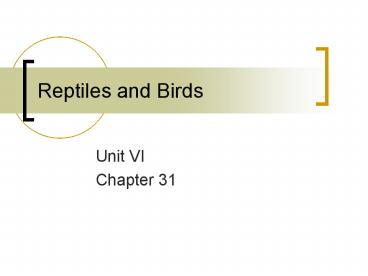Reptiles and Birds - PowerPoint PPT Presentation
1 / 21
Title:
Reptiles and Birds
Description:
Order Rhynchocephalia beak-headed reptiles. Birds ... A bird's beak, or bill, is adapted to the type of food they eat. Bird Digestion. Bird Respiration ... – PowerPoint PPT presentation
Number of Views:1425
Avg rating:3.0/5.0
Title: Reptiles and Birds
1
Reptiles and Birds
- Unit VI
- Chapter 31
2
Reptiles
- A reptile is a vertebrate that has dry, scaly
skin, lungs, and terrestrial eggs with several
membranes
3
Form and Function in Reptiles
- Most reptiles have adapted to a fully terrestrial
life - tough, scaly skin
- well developed lungs
- a double-loop circulatory system
- a water-conserving excretory system
- strong limbs
- internal fertilization
- shelled, terrestrial eggs
- control of body temperature by changing their
environment
4
Body Temperature Control in Reptiles
- Reptiles are ectotherms
- They rely on behavior to help control body
temperature - To warm up, they bask in the sun
- To cool down, they move to the shade
5
Reptile Feeding Respiration
- Reptiles range from herbivores to carnivores
- The lungs of reptiles are spongy, providing more
gas exchange area than those of amphibians - Most reptiles have 2 efficient lungs to exchange
gas with the environment
6
Reptile Circulation Excretion
- Reptiles have an efficient double-loop
circulatory system - Their heart contains two atria and either one or
two ventricles - Urine is produced in the kidneys of reptiles
- By eliminating wastes that contain little water,
a reptile can conserve water
7
Reptile Circulatory System
8
Reptile Response
- The basic pattern of a reptiles brain is similar
to that of an amphibian - In addition to a pair of nostrils, most reptiles
have a pair of sensory organs in the roof of the
mouth that can detect chemicals - Reptiles have simple ears and can pick up on
ground vibrations and body heat
9
Reptile Reproduction
- All reptiles reproduce by internal fertilization
- Most reptiles are oviparous (lay eggs that
develop outside the mothers body) - Reptilian eggs are amniotic
- They contain a shell and membranes that create a
protected environment in which the embryo can
develop without drying out
10
Structure of an Amniotic Egg
11
Groups of Reptiles
- Lizards and snakes
- Order Squamata scaly reptiles
- Crocodilians
- Order Crocolilia
- Turtles and tortoises
- Order Chelonia
- Tuatara
- Order Rhynchocephalia beak-headed reptiles
12
Birds
- Birds are reptile-like animals that maintain a
constant internal body temperature - They have an outer covering of feathers two legs
that are covered with scales and front limbs
modified into wings
13
Birds
- This single most important characteristic that
separates birds from living reptiles, and from
all other living animals, is feathers - Feathers are made mostly of protein and develop
from pits in the birds skin - Feathers help birds fly and also help to keep
them warm - The 2 main types of feathers are contour feathers
and down feathers
14
Form, Function, and Flight
- Birds have a number of adaptations that enable
them to fly - Highly efficient digestive, respiratory, and
circulatory systems - Aerodynamic feathers and wings
- Strong chest muscles
15
Form, Function, and Flight
16
Body Temperature and Control in Birds
- Birds are endotherms (animals that can generate
their own body heat) - They have a high rate of metabolism compared to
ectotherms (metabolism produces heat) - A birds feathers insulate its body enough to
conserve most of its metabolic energy
17
Bird Feeding
- The more food a bird eats, the more heat energy
its metabolism can generate - For this reason, the phrase eats like a bird is
quite misleading birds are voracious eaters - A birds beak, or bill, is adapted to the type of
food they eat
18
Bird Digestion
19
Bird Respiration
- When a bird inhales, most air first enters large
posterior air sacs in the body cavity and bones - The inhaled air then flows through the lungs in a
series of small tubes - A complex system of air sacs and breathing tubes
ensures that air flows into the air sacs and out
through the lungs in a single direction - This constant, one way flow of oxygen-rich air
helps birds maintain their high metabolic rate
and generates enough energy for flight
20
Circulation, Excretion, and Response in Birds
- Circulation
- 4 chambered hearts and two separate circulatory
loops - Excretion
- Similar to those of reptiles white, pasty uric
acid droppings - Response
- Well developed sense organs
- Well developed eyes that can see color
- Excellent hearing
21
Reproduction in Birds
- Bird eggs are amniotic eggs
- They have hard outer shells
- Most birds incubate their eggs until they hatch

